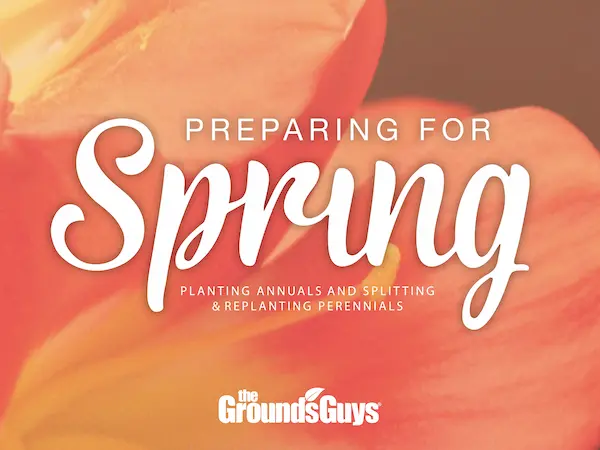Preparing for Spring: Planting Annuals & Splitting and Replanting Perennials

Punxsutawney Phil in Punxsutawney, Pa., has spoken… we can expect an early spring this year! As onlookers witnessed at the annual Groundhog Day event, the beloved groundhog did not see his shadow. Whether Phil was spot on or a little off on his predication, it’s time to start making your preparations to have a beautiful and healthy spring garden.
Do you need a little help getting started with your spring clean up and garden preparation? The experts at The Grounds Guys® offer these simple gardening tips to help you hit the ground running as soon as the winter ground thaws.
Planting Annuals
Some plants grow throughout the warmer months and then die when it gets cold. These are called annuals, and you need to replant them every spring. Since the plants die each year and don’t come back, you’re not making a huge commitment with annuals, but you still want your garden to looks its best for as long as possible.
Tips for Planting Annuals
- Plant at the right time based on your climate: If you live in a cold-winter climate, wait until the danger of a late frost has passed before you plant warm-season annuals. Mid-spring is also the right time to plant warm-season annuals if you live in a warm-winter area. For cool-season annuals, plant in very early spring if you live in a cold-winter climate. Fall is the best time to plant cool-season annuals if you live in a warm-season climate.
- Give your annuals a strong start: If you’re afraid of a late frost, but you want to get your annuals growing, plant seeds in an indoor pot to transplant later. You can also wait a few weeks into the season and purchase plants from a nursery. Choose relatively small plants with healthy foliage for the best results.
- Water regularly: Seedlings and transplants may require water every day, but once they become established, you should only water when the soil starts to become dry. About seven centimetres of mulch can help reduce evaporation and prevent weeds from becoming established.
Splitting and Replanting Perennials
Other types of plants grow throughout the warmer months, die back to the ground in the winter and come back from the roots every spring. These are called perennials, and while you only need to plant these once, you may want to split and replant them every few years.
Reasons to Split and Replant Perennials
- The plant has grown too large: When a plant starts leaning over a pathway or encroaching on neighbouring plants, removing some of it helps restore the look of your garden.
- The plant is getting old: As perennials age, they start to become weak in the centre, producing smaller leaves and fewer flowers.
- The plant isn’t growing well anymore: After several seasons, surrounding trees and shrubs may overshadow your perennials, causing them to grow poorly or become hidden from site. Replanting them elsewhere can give new life to your garden.
- You want to share your plant: The beauty of perennials is that you can divide and replant – not just in your own garden, but in a friend’s garden who has admired your unique plant for years.
Tips for Splitting and Replanting Perennials
- Divide in cool weather: You can technically divide perennials at any time, but for the quickest reestablishment, divide in the spring or fall.
- Replant small sections: Smaller offshoots of the original plant tend to grow vigorously and produce long-lasting blooms. This means you shouldn’t simply divide an existing plant exactly in half or you’ll just end up needing to split and replant both halves again next season.
- Replant only the healthiest pieces: If a plant has succumbed to pest problems, splitting and replanting is a great way to save it. Look for symptoms of disease in the plant’s roots and throw these pieces away rather than replanting them.
If you need help preparing your residential or commercial garden for spring, let The Grounds Guys help you create your very own spring garden paradise.
For Further Reading:
Spring Gardens: A Canvas of Color
Evaluate and Plan Next Year’s Gardens
5 Ways to Effectively Use Your Compost
Click here for an overview of how we can help you meet your landscaping needs.
 Click to call
Click to call


